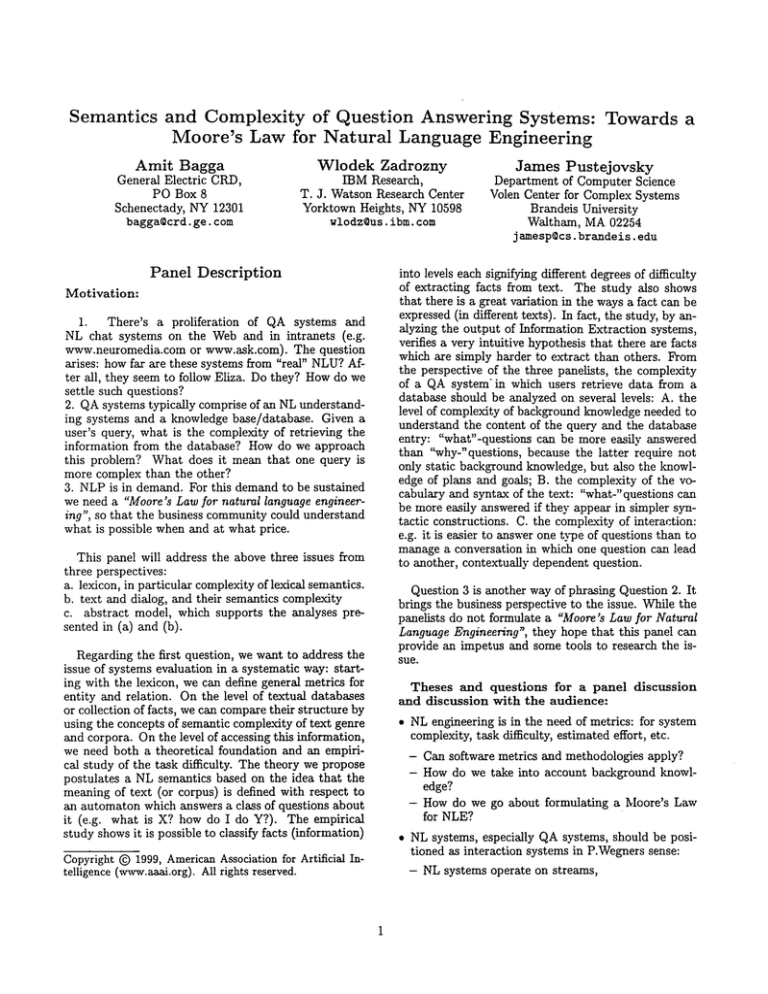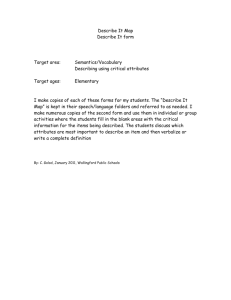
Semantics
and Complexity of Question Answering Systems:
Moore’s Law for Natural Language Engineering
Amit
Bagga
General Electric CRD,
PO Box 8
Schenectady, NY 12301
bagga©crd, ge. com
Panel
Wlodek
Zadrozny
IBM Research,
T. J. Watson Research Center
Yorktown Heights, NY10598
wlodz@us,
ibm.com
Description
Motivation:
1. There’s a proliferation
of QA systems and
NL chat systems on the Weband in intranets (e.g.
www.neuromedia.com or www.ask.com). The question
arises: howfar are these systems from "real" NLU?After all, they seem to follow Eliza. Do they? Howdo we
settle such questions?
2. QAsystems typically comprise of an NLunderstanding systems and a knowledge base/database. Given a
user’s query, what is the complexity of retrieving the
information from the database? How do we approach
this problem? What does it mean that one query is
more complex than the other?
3. NLPis in demand. For this demand to be sustained
we need a "Moore’s Law for natural language engineering", so that the business community could understand
what is possible when and at what price.
This panel will address the above three issues from
three perspectives:
a. lexicon, in particular complexity of lexical semantics.
b. text and dialog, and their semantics complexity
c. abstract model, which supports the analyses presented in (a) and (b).
Regarding the first question, we want to address the
issue of systems evaluation in a systematic way: starting with the lexicon, we can define general metrics for
entity and relation. On the level of textual databases
or collection of facts, we can comparetheir structure by
using the concepts of semantic complexity of text genre
and corpora. On the level of accessing this information,
we need both a theoretical foundation and an empirical study of the task difficulty. The theory we propose
postulates a NL semantics based on the idea that the
meaning of text (or corpus) is defined with respect
an automaton which answers a class of questions about
it (e.g. what is X? how do I do Y?). The empirical
study showsit is possible to classify facts (information)
Copyright (~) 1999, AmericanAssociation for Artificial Intelligence (www.aaai.org).All rights reserved.
Towards a
James Pustejovsky
Department of Computer Science
Volen Center for Complex Systems
Brandeis University
Waltham, MA02254
j amesp@cs,
brandeis,
edu
into levels each signifying different degrees of dimculty
of extracting facts from text. The study also shows
that there is a great variation in the ways a fact can be
expressed (in different texts). In fact, the study, by analyzing the output of Information Extraction systems,
verifies a very intuitive hypothesis that there are facts
which are simply harder to extract than others. From
the perspective of the three panelists, the complexity
of a QAsystem’in which users retrieve data from a
database should be analyzed on several levels: A. the
level of complexity of background knowledge needed to
understand the content of the query, and the database
entry: "what"-questions can be more easily answered
than ’~why-’questions, because the latter require not
only static background knowledge, but also the knowledge of plans and goals; B. the complexity of the vocabulary and syntax of the text: "what-" questions can
be more easily answered if they appear in simpler syntactic constructions. C. the complexity of interaction:
e.g. it is easier to answer one type of questions than to
manage a conversation in which one question can lead
to another, contextually dependent question.
Question 3 is another way of phrasing Question 2. It
brings the business perspective to the issue. While the
panelists do not formulate a "Moore’s Law for Natural
Language Engineering", they hope that this panel can
provide an impetus and some tools to research the issue.
Theses and questions
for a panel
and discussion with the audience:
discussion
¯ NLengineering is in the need of metrics: for system
complexity, task di~culty, estimated effort, etc.
- Can software metrics and methodologies apply?
- How do we take into account background knowledge?
- How do we go about formulating a Moore’s Law
for NLE?
* NL systems, especially QAsystems, should be positioned as interaction systems in P.Wegners sense:
- NL systems operate on streams,
- NL grammars can be viewed as collections of objects (in the software engineering sense).
¯ NL semantics should be contextual and task dependent
- It is possible to define a semantics based on inter°
active, task dependent QAbehavior.
- Such a semantics is consistent with the compositionality postulate
¯ NL semantics should be modular and task independent; such a semantics can support different tasks
with minimumcustomization.
¯ Can these two views coexist?









